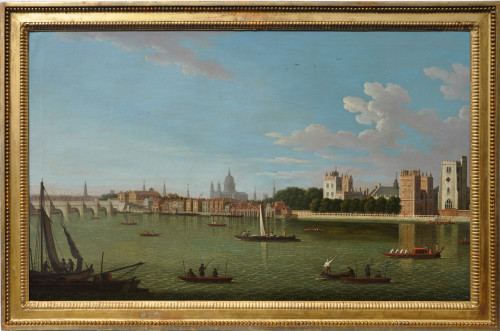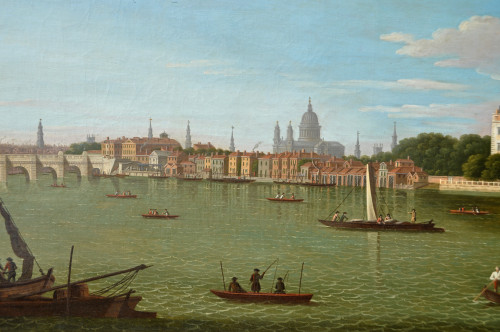A Royal Navy Two-Decker and other Shipping off Gibraltar
A Royal Navy Two-Decker and other Shipping off Gibraltar
Oil on canvas
The work of Thomas Yates does not appear very often because of his brief working career. He was appointed to the rank of lieutenant in the Royal Navy in 1782 and like other officers such as William Elliott (fl. 1784-1791), Thomas Luny (1759-1837), Nicholas Pocock (1740-1821) and Rear-Admiral George Tobin (1768-1838) made numerous studies and sketches while travelling the world in the line of duty. Apart from the topographical range that this travel afforded, these gifted, initially amateur, artists would have an expert's eye for the technicalities of sailing ships and the way the sea and sky looked in all its climactic manifestations.
The date when Yates resigned his commission to become a painter is unknown but he exhibited his first painting - View of the Bay of Bull, on the coast of Newfoundland - at the Royal Academy in 1788 where he is listed as Lieut. Thomas Yates R.N. Painter (An Honorary Exhibitor). He exhibited nine paintings in total at the R.A. which represent his acute and exacting knowledge of ships and experience at sea with the Royal Navy with titles such as: A squadron of men on war lying off Gibraltar Bay; taken from the King's Bastion; Lord Howe with the grand fleet at Spithead, 1790; La Nymphe's main mast disentangled through the gallantry of a British seaman and Representation of the action off Dogger Bank.
He engraved and published from his own drawings a set of Celebrated Naval Actions and Grant writes of these that "Extant examples display a skill equal to most painters in that line; nor was it less in some peaceful views of harbours and quays, one of which is as placid as a Monamy or a Swaine and not unlike them."
Thomas Yates was married to a famous actress of the time who had appeared in Arthur Murphy's dramatic play The Grecian Daughter which had opened at Drury Lane in 1772. This play was immensely popular at the time and the renowned Sarah Siddons had also played the lead.
His great uncle, Richard Yates, was a celebrated comedian and it was this connection that led to the painter's untimely death. His uncle, at the time of his death, had bequeathed his house in London to a Miss Jones and Yates must have had the right to live there also. However, an acrimonious dispute arose as to who was the actual owner of the property. On 29th August 1796, Yates took a post-lunch stroll alone in the garden as his wife was out and Miss Jones locked the doors to bar his re-entry. Miss Jones had a supporter named Mr Sellers who was on the premises to protect her and when he saw Yates climbing in through the kitchen window, Sellers shot him. The ensuing trial resulted in the jury returning a verdict of manslaughter on the assailant and for this Sellers was sent to prison for six months and fined one shilling.
The National Maritime Museum in Greenwich has HMS Scourge capturing the Sansculotte in its collection.
Bibliography:
Dictionary of Sea Painters - E H H Archibald
Dictionary of British Landscape Painters - M H Grant
Dictionary of British Marine Painters - Arnold Wilson
Dictionary of British Watercolour Artists up to 1920 - H C Mallalieu
The Dictionary of British 18th Century Painters - Ellis Waterhouse
Dimensions:
Born c.1760 died 1796
Oil on canvas
England
RELATED ITEMS
























